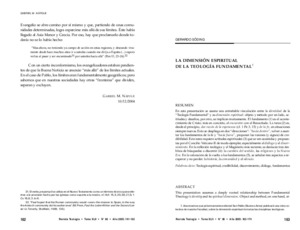Por favor, use este identificador para citar o enlazar este ítem:
https://repositorio.uca.edu.ar/handle/123456789/18294| Título: | La dimensión espiritual de la teología fundamental | Autor: | Söding, Gerardo José | Palabras clave: | TEOLOGIA ESPIRITUAL; CREDIBILIDAD; DISCERNIMIENTO; DIALOGO | Fecha de publicación: | 2005 | Editorial: | Pontificia Universidad Católica Argentina. Facultad de Teología | Cita: | Söding, G. J. La dimensión espiritual de la teología fundamental [en línea]. Teología. 2005, 42 (86). Disponible en: https://repositorio.uca.edu.ar/handle/123456789/18294 | Resumen: | Resumen: En esta presentación se asume una entrañable vinculación entre la identidad de la
“Teología Fundamental” y su dimensión espiritual: objeto y método por un lado, actitudes
y desafíos, por otro, se implican mutuamente. El fundamento (1) es el acontecimiento
de Cristo; más en concreto, el encuentro con el Resucitado. La tarea (2) es,
desde el principio, dar razón de la esperanza (cf. 1 Pe 3, 15) y de la fe, en situaciones
siempre nuevas. Esto se despliega en dos “direcciones”: “hacia dentro”, volver a asentar
los fundamentos de la fe y “hacia fuera”, proponer las razones (y signos) de credibilidad.
Esta tarea requiere actitudes espirituales (3) que se ven asumidas y propuestas
por el Concilio Vaticano II de modo ejemplar, especialmente el diálogo y el discernimiento.
En la reflexión teológica y el Magisterio más reciente, se destacan tres ámbitos
de búsquedas a discernir (4): la cuestión del sentido, las religiones y la Nueva
Era. En la valoración de la vuelta a los fundamentos (5), se señalan tres aspectos a recuperar
y no perder: la historia, la comunidad y el silencio. Abstract: This presentation assumes a deeply rooted relationship between Fundamental Theology’s identity and its spiritual dimension. Object and method, on one hand, attitudes and challenges, on the other, imply each other. The basis (1) is Christ’s coming, more precisely, our encounter with Him. The task (2) is, from the beginning, Always be prepared to give an answer for the reasons of the hope that you have (cf. 1 Pe 3, 15), on ever changing situations. This tends towards two ends: inwards and outwards. Inwards, to set once more the pillars of faith, outwards, to propose reasons and signs of credibility. This task requires spiritual attitudes (3) which were assumed as an example by the II Vatican Council: dialogue and discernment. Recent theological reflection and Magistery point out three search areas (4): the question about sense, religions, and New Age. In this back to basics movement (5), three points should be cared for: history, community and silence. |
URI: | https://repositorio.uca.edu.ar/handle/123456789/18294 | ISSN: | 0328-1396 (impreso) 2683-7307 (online) |
Disciplina: | TEOLOGIA | Derechos: | Acceso abierto | Fuente: | Teología. 2005, 42 (86) |
| Aparece en las colecciones: | TEO - 2005 Tomo XLII nro. 086 |
Ficheros en este ítem:
| Fichero | Descripción | Tamaño | Formato | |
|---|---|---|---|---|
| dimension-espiritual- teologia.pdf | 58,09 kB | Adobe PDF |  Visualizar/Abrir |
Este ítem está sujeto a una Licencia Creative Commons

